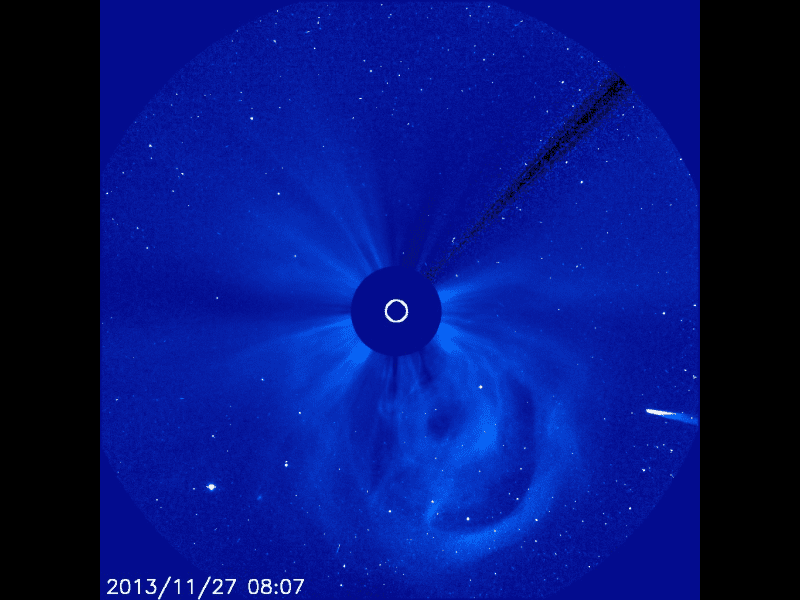UPDATE: Telescopes saw the giant ball of ice and dust disappear behind the star, but then fail to emerge as expected. ISON is dead and gone, folks. Sorry.
The ISON comet, a giant icy cosmic body from deep space, may just become the most spectacular comet ever – if it lives past today’s Thanksgiving that is. Appropriately enough, NASA researchers have a roast of their own today as the comet is expected to make its closest flyby to the sun yet. If it survives the drift past the sun, it will go on to shine for months in the night’s sky where the comet will be visible with the naked eye. There’s a pretty solid chance the comet will get zapped too, transiting for possible spectacle of the century to a big pile of dust and gas. So, are you feeling lucky?

This magnificent photo was taken in the very earlier hours of November 27, showing the sun at the very center. In the picture, called a coronagraph and recorded by the NASA Solar and Heliospheric Observatory, the sun’s bright light was blocked such that other structures around it could be seen. In the lower right-hand side you can see long and bright object followed by a trailing tail – that’s ISON. Wouldn’t you know it, the timing couldn’t had been any better, since the photo also caught a coronal mass ejection in full swing. The tremendous ejection of particles and energy can be seen in the upper right-hand side as a narrow black beam.
In just a couple of hours, comet ISON will be making its closest flyby to the sun, skimming just 730,000 miles above its surface. The event will take place precisely at 1:38 p.m. EST (1838 GMT), and like I said earlier, if the comet survives the flyby, it will live to become one of the most spectacular comets witnessed by mankind yet.
“This is really a critical time, arguably the most critical time, for Comet ISON,” said astrophysicist Karl Battams of the U.S. Naval Research Laboratory in Washington, D.C. “It is experiencing the most intense solar radiation and the most intense gravitational forces.”
ISON was discovered by a group of Russian astronomers in September 2012, but despite over a year of tracking and observations it’s still unclear whether or not the comet will survive disintegration. Some facts about ISON that we know fore sure: it’s a remnant from the solar system’s early days, being 4.5 billion years and originating from the Oort cloud region; currently, the comet is 1 mile wide and is made up of 2 billion tons of ice and dust, which it will gradually lose during its close encounters with the sun. If it survives the flyby, the comet will orbit back to the Oort cloud region from which in won’t ever come back, NASA researchers says, meaning this is a once in a lifetime opportunity – even for the whole of mankind.
From 1 p.m. to 3:30 p.m. EST (1800 to 2030 GMT) NASA will host a live Google Hangout discussing ISON and its progression as it comes closer and closer to the sun’s surface. You can watch it live here.
The question on everybody’s mind must be, “what are the odds of ISON surviving?” Well, it’s very hard to predict, but a NASA spokesman was quoted saying that there’s a 40% chance ISON will make it in one piece. What a Thanksgiving this will be!






